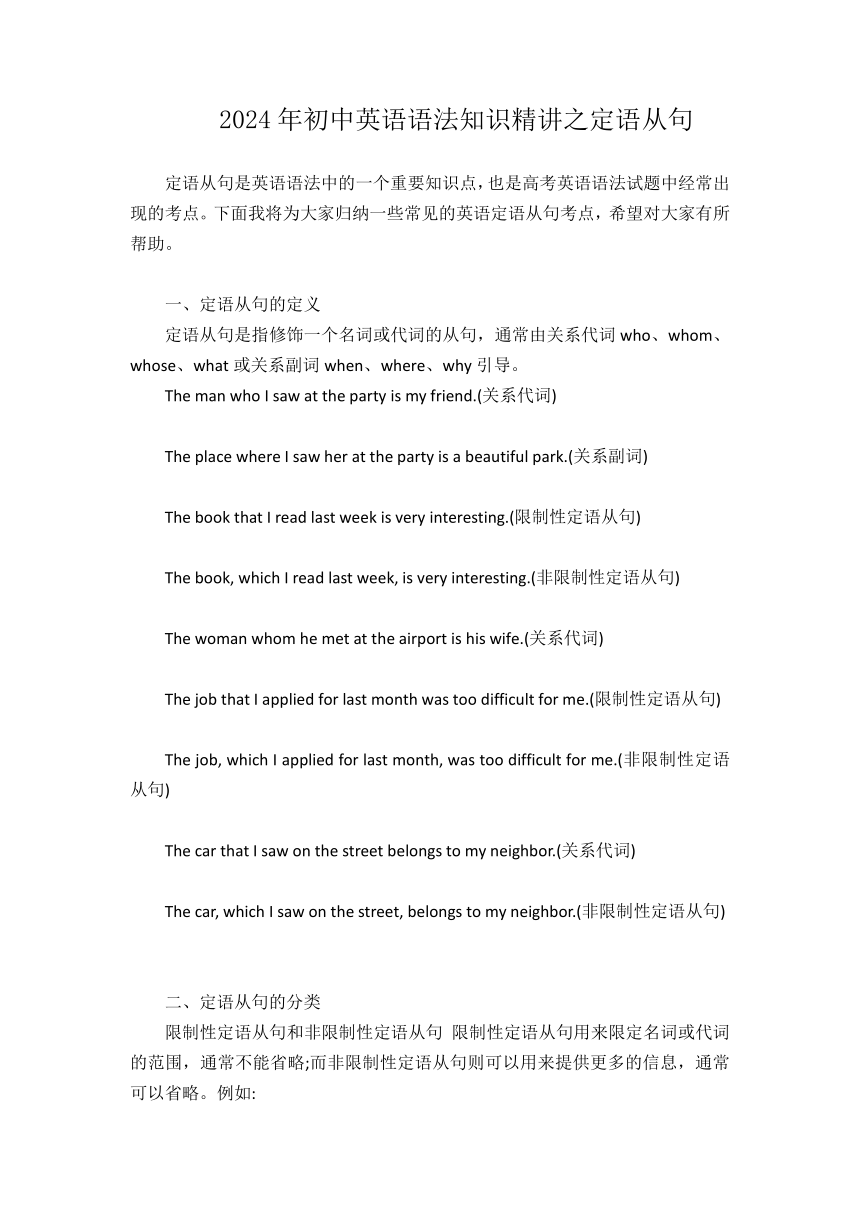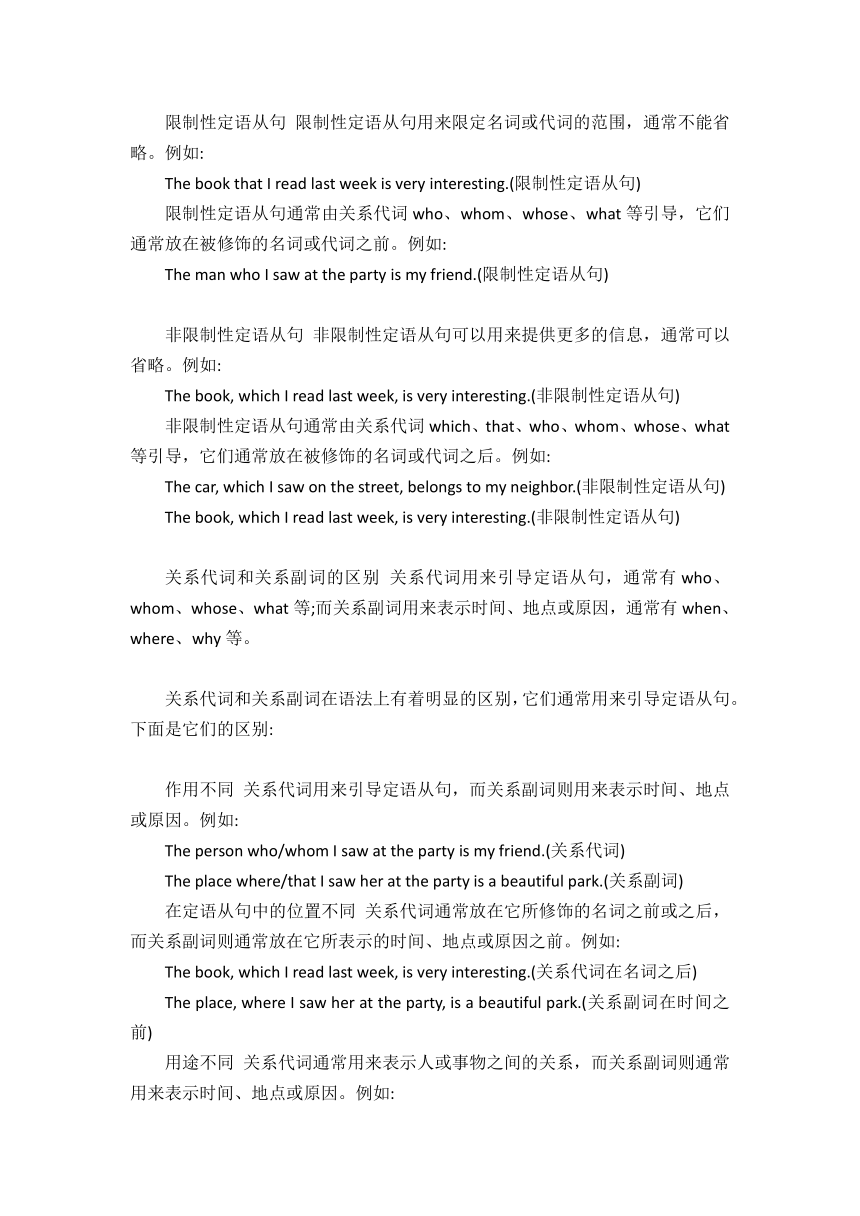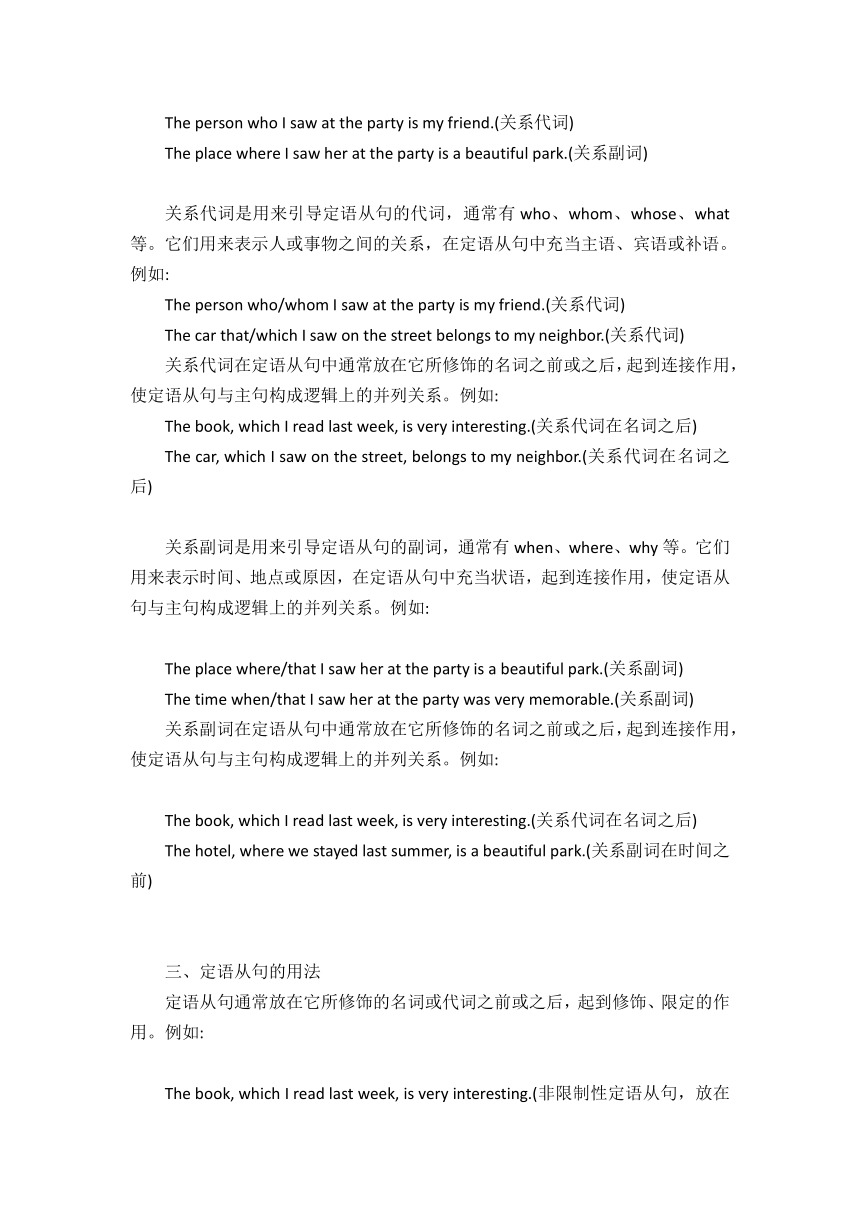2024年初中英语语法知识精讲之定语从句
文档属性
| 名称 | 2024年初中英语语法知识精讲之定语从句 |  | |
| 格式 | docx | ||
| 文件大小 | 19.4KB | ||
| 资源类型 | 教案 | ||
| 版本资源 | 人教新目标(Go for it)版 | ||
| 科目 | 英语 | ||
| 更新时间 | 2024-04-07 12:06:37 | ||
图片预览



文档简介
2024年初中英语语法知识精讲之定语从句
定语从句是英语语法中的一个重要知识点,也是高考英语语法试题中经常出现的考点。下面我将为大家归纳一些常见的英语定语从句考点,希望对大家有所帮助。
一、定语从句的定义
定语从句是指修饰一个名词或代词的从句,通常由关系代词who、whom、whose、what或关系副词when、where、why引导。
The man who I saw at the party is my friend.(关系代词)
The place where I saw her at the party is a beautiful park.(关系副词)
The book that I read last week is very interesting.(限制性定语从句)
The book, which I read last week, is very interesting.(非限制性定语从句)
The woman whom he met at the airport is his wife.(关系代词)
The job that I applied for last month was too difficult for me.(限制性定语从句)
The job, which I applied for last month, was too difficult for me.(非限制性定语从句)
The car that I saw on the street belongs to my neighbor.(关系代词)
The car, which I saw on the street, belongs to my neighbor.(非限制性定语从句)
二、定语从句的分类
限制性定语从句和非限制性定语从句 限制性定语从句用来限定名词或代词的范围,通常不能省略;而非限制性定语从句则可以用来提供更多的信息,通常可以省略。例如:
限制性定语从句 限制性定语从句用来限定名词或代词的范围,通常不能省略。例如:
The book that I read last week is very interesting.(限制性定语从句)
限制性定语从句通常由关系代词who、whom、whose、what等引导,它们通常放在被修饰的名词或代词之前。例如:
The man who I saw at the party is my friend.(限制性定语从句)
非限制性定语从句 非限制性定语从句可以用来提供更多的信息,通常可以省略。例如:
The book, which I read last week, is very interesting.(非限制性定语从句)
非限制性定语从句通常由关系代词which、that、who、whom、whose、what等引导,它们通常放在被修饰的名词或代词之后。例如:
The car, which I saw on the street, belongs to my neighbor.(非限制性定语从句)
The book, which I read last week, is very interesting.(非限制性定语从句)
关系代词和关系副词的区别 关系代词用来引导定语从句,通常有who、whom、whose、what等;而关系副词用来表示时间、地点或原因,通常有when、where、why等。
关系代词和关系副词在语法上有着明显的区别,它们通常用来引导定语从句。下面是它们的区别:
作用不同 关系代词用来引导定语从句,而关系副词则用来表示时间、地点或原因。例如:
The person who/whom I saw at the party is my friend.(关系代词)
The place where/that I saw her at the party is a beautiful park.(关系副词)
在定语从句中的位置不同 关系代词通常放在它所修饰的名词之前或之后,而关系副词则通常放在它所表示的时间、地点或原因之前。例如:
The book, which I read last week, is very interesting.(关系代词在名词之后)
The place, where I saw her at the party, is a beautiful park.(关系副词在时间之前)
用途不同 关系代词通常用来表示人或事物之间的关系,而关系副词则通常用来表示时间、地点或原因。例如:
The person who I saw at the party is my friend.(关系代词)
The place where I saw her at the party is a beautiful park.(关系副词)
关系代词是用来引导定语从句的代词,通常有who、whom、whose、what等。它们用来表示人或事物之间的关系,在定语从句中充当主语、宾语或补语。例如:
The person who/whom I saw at the party is my friend.(关系代词)
The car that/which I saw on the street belongs to my neighbor.(关系代词)
关系代词在定语从句中通常放在它所修饰的名词之前或之后,起到连接作用,使定语从句与主句构成逻辑上的并列关系。例如:
The book, which I read last week, is very interesting.(关系代词在名词之后)
The car, which I saw on the street, belongs to my neighbor.(关系代词在名词之后)
关系副词是用来引导定语从句的副词,通常有when、where、why等。它们用来表示时间、地点或原因,在定语从句中充当状语,起到连接作用,使定语从句与主句构成逻辑上的并列关系。例如:
The place where/that I saw her at the party is a beautiful park.(关系副词)
The time when/that I saw her at the party was very memorable.(关系副词)
关系副词在定语从句中通常放在它所修饰的名词之前或之后,起到连接作用,使定语从句与主句构成逻辑上的并列关系。例如:
The book, which I read last week, is very interesting.(关系代词在名词之后)
The hotel, where we stayed last summer, is a beautiful park.(关系副词在时间之前)
三、定语从句的用法
定语从句通常放在它所修饰的名词或代词之前或之后,起到修饰、限定的作用。例如:
The book, which I read last week, is very interesting.(非限制性定语从句,放在名词之后)
The car, which I saw on the street, belongs to my neighbor.(非限制性定语从句,放在名词之后)
The man, who I saw at the party, is my friend.(限制性定语从句,放在名词之前)
当定语从句所修饰的名词或代词已经明确时,定语从句可以省略。例如:
The book, which I read last week, is very interesting.(非限制性定语从句,可以省略)
The car, which I saw on the street, belongs to my neighbor.(非限制性定语从句,可以省略)
The man, who I saw at the party, is my friend.(限制性定语从句,不能省略)
当定语从句嵌套使用时,需要注意主从句的关系和语序。例如:
The book, which I read last week, that I borrowed from the library, is very interesting.(非限制性定语从句嵌套)
The car, which I saw on the street, that belongs to my neighbor, is very beautiful.(非限制性定语从句嵌套)
在以上例句中,定语从句被嵌套在另一个定语从句中,需要注意主从句的关系和语序。例如,第一个例句中的定语从句“which I read last week”修饰“book”,第二个例句中的定语从句“that I borrowed from the library”修饰“book”。同时,在两个定语从句中,关系代词和关系副词的位置也需要保持一致。
关于"that"的用法,我们可以从以下几个方面进行讨论:
"that"在定语从句中的用法
当定语从句为陈述句时,"that"可以用于指代先行词,例如:"I saw a beautiful bird in the park that I had never seen before."(我在公园里看到了一只我从来没有见过的美丽鸟。)
"that"在强调句中的用法
当主语为第三人称单数时,"that"可以用于强调主语,例如:"That is a beautiful day."(那是一个美丽的一天。)
"that"在虚拟语气中的用法
当表示假设、愿望等虚拟语气时,"that"可以用于代替从句中的谓语动词,例如:"I wish that I could be there with you."(我希望我能和你在一起。)
"that"在连接词中的用法
当连接两个名词或代词时,"that"可以用于代替前面的名词或代词,例如:"The book that I read last week is really interesting."(我上周读的那本书非常有趣。)
关于"which"的用法,我们可以从以下几个方面进行讨论:
"which"在定语从句中的用法
当定语从句为陈述句时,"which"可以用于指代先行词,例如:"I saw a beautiful bird in the park which I had never seen before."(我在公园里看到了一只我从来没有见过的美丽鸟。)
"which"在强调句中的用法
当主语为第三人称单数时,"which"可以用于强调主语,例如:"Which is a beautiful day."(那是一个美丽的一天。)
"which"在虚拟语气中的用法
当表示假设、愿望等虚拟语气时,"which"可以用于代替从句中的谓语动词,例如:"I wish which I could be there with you."(我希望我能和你在一起。)
"which"在连接词中的用法
当连接两个名词或代词时,"which"可以用于代替前面的名词或代词,例如:"The book which I read last week is really interesting."(我上周读的那本书非常有趣。)
关于"as"的用法,我们可以从以下几个方面进行讨论:
"as"在比较句中的用法
当用于比较两个事物的相似性时,"as"可以表示同等程度、同样程度等含义,例如:"This room is as large as that one."(这个房间和那个房间一样大。)
"as"在引导定语从句时的用法
当用于引导定语从句时,"as"可以表示类比关系,例如:"As beautiful as a flower."(像一朵花一样美丽。)
"as"在引导状语从句时的用法
当用于引导状语从句时,"as"可以表示方式、时间、原因等,例如:"As you have finished your homework, you can go out to play."(当你完成你的作业后,你可以出去玩耍。)
"as"在连接词中的用法
当用于连接两个名词或代词时,"as"可以表示代替前面的名词或代词,例如:"I saw the same man as you did."(我看到了和你一样的男人。)
定语从句是英语语法中的一个重要知识点,也是高考英语语法试题中经常出现的考点。下面我将为大家归纳一些常见的英语定语从句考点,希望对大家有所帮助。
一、定语从句的定义
定语从句是指修饰一个名词或代词的从句,通常由关系代词who、whom、whose、what或关系副词when、where、why引导。
The man who I saw at the party is my friend.(关系代词)
The place where I saw her at the party is a beautiful park.(关系副词)
The book that I read last week is very interesting.(限制性定语从句)
The book, which I read last week, is very interesting.(非限制性定语从句)
The woman whom he met at the airport is his wife.(关系代词)
The job that I applied for last month was too difficult for me.(限制性定语从句)
The job, which I applied for last month, was too difficult for me.(非限制性定语从句)
The car that I saw on the street belongs to my neighbor.(关系代词)
The car, which I saw on the street, belongs to my neighbor.(非限制性定语从句)
二、定语从句的分类
限制性定语从句和非限制性定语从句 限制性定语从句用来限定名词或代词的范围,通常不能省略;而非限制性定语从句则可以用来提供更多的信息,通常可以省略。例如:
限制性定语从句 限制性定语从句用来限定名词或代词的范围,通常不能省略。例如:
The book that I read last week is very interesting.(限制性定语从句)
限制性定语从句通常由关系代词who、whom、whose、what等引导,它们通常放在被修饰的名词或代词之前。例如:
The man who I saw at the party is my friend.(限制性定语从句)
非限制性定语从句 非限制性定语从句可以用来提供更多的信息,通常可以省略。例如:
The book, which I read last week, is very interesting.(非限制性定语从句)
非限制性定语从句通常由关系代词which、that、who、whom、whose、what等引导,它们通常放在被修饰的名词或代词之后。例如:
The car, which I saw on the street, belongs to my neighbor.(非限制性定语从句)
The book, which I read last week, is very interesting.(非限制性定语从句)
关系代词和关系副词的区别 关系代词用来引导定语从句,通常有who、whom、whose、what等;而关系副词用来表示时间、地点或原因,通常有when、where、why等。
关系代词和关系副词在语法上有着明显的区别,它们通常用来引导定语从句。下面是它们的区别:
作用不同 关系代词用来引导定语从句,而关系副词则用来表示时间、地点或原因。例如:
The person who/whom I saw at the party is my friend.(关系代词)
The place where/that I saw her at the party is a beautiful park.(关系副词)
在定语从句中的位置不同 关系代词通常放在它所修饰的名词之前或之后,而关系副词则通常放在它所表示的时间、地点或原因之前。例如:
The book, which I read last week, is very interesting.(关系代词在名词之后)
The place, where I saw her at the party, is a beautiful park.(关系副词在时间之前)
用途不同 关系代词通常用来表示人或事物之间的关系,而关系副词则通常用来表示时间、地点或原因。例如:
The person who I saw at the party is my friend.(关系代词)
The place where I saw her at the party is a beautiful park.(关系副词)
关系代词是用来引导定语从句的代词,通常有who、whom、whose、what等。它们用来表示人或事物之间的关系,在定语从句中充当主语、宾语或补语。例如:
The person who/whom I saw at the party is my friend.(关系代词)
The car that/which I saw on the street belongs to my neighbor.(关系代词)
关系代词在定语从句中通常放在它所修饰的名词之前或之后,起到连接作用,使定语从句与主句构成逻辑上的并列关系。例如:
The book, which I read last week, is very interesting.(关系代词在名词之后)
The car, which I saw on the street, belongs to my neighbor.(关系代词在名词之后)
关系副词是用来引导定语从句的副词,通常有when、where、why等。它们用来表示时间、地点或原因,在定语从句中充当状语,起到连接作用,使定语从句与主句构成逻辑上的并列关系。例如:
The place where/that I saw her at the party is a beautiful park.(关系副词)
The time when/that I saw her at the party was very memorable.(关系副词)
关系副词在定语从句中通常放在它所修饰的名词之前或之后,起到连接作用,使定语从句与主句构成逻辑上的并列关系。例如:
The book, which I read last week, is very interesting.(关系代词在名词之后)
The hotel, where we stayed last summer, is a beautiful park.(关系副词在时间之前)
三、定语从句的用法
定语从句通常放在它所修饰的名词或代词之前或之后,起到修饰、限定的作用。例如:
The book, which I read last week, is very interesting.(非限制性定语从句,放在名词之后)
The car, which I saw on the street, belongs to my neighbor.(非限制性定语从句,放在名词之后)
The man, who I saw at the party, is my friend.(限制性定语从句,放在名词之前)
当定语从句所修饰的名词或代词已经明确时,定语从句可以省略。例如:
The book, which I read last week, is very interesting.(非限制性定语从句,可以省略)
The car, which I saw on the street, belongs to my neighbor.(非限制性定语从句,可以省略)
The man, who I saw at the party, is my friend.(限制性定语从句,不能省略)
当定语从句嵌套使用时,需要注意主从句的关系和语序。例如:
The book, which I read last week, that I borrowed from the library, is very interesting.(非限制性定语从句嵌套)
The car, which I saw on the street, that belongs to my neighbor, is very beautiful.(非限制性定语从句嵌套)
在以上例句中,定语从句被嵌套在另一个定语从句中,需要注意主从句的关系和语序。例如,第一个例句中的定语从句“which I read last week”修饰“book”,第二个例句中的定语从句“that I borrowed from the library”修饰“book”。同时,在两个定语从句中,关系代词和关系副词的位置也需要保持一致。
关于"that"的用法,我们可以从以下几个方面进行讨论:
"that"在定语从句中的用法
当定语从句为陈述句时,"that"可以用于指代先行词,例如:"I saw a beautiful bird in the park that I had never seen before."(我在公园里看到了一只我从来没有见过的美丽鸟。)
"that"在强调句中的用法
当主语为第三人称单数时,"that"可以用于强调主语,例如:"That is a beautiful day."(那是一个美丽的一天。)
"that"在虚拟语气中的用法
当表示假设、愿望等虚拟语气时,"that"可以用于代替从句中的谓语动词,例如:"I wish that I could be there with you."(我希望我能和你在一起。)
"that"在连接词中的用法
当连接两个名词或代词时,"that"可以用于代替前面的名词或代词,例如:"The book that I read last week is really interesting."(我上周读的那本书非常有趣。)
关于"which"的用法,我们可以从以下几个方面进行讨论:
"which"在定语从句中的用法
当定语从句为陈述句时,"which"可以用于指代先行词,例如:"I saw a beautiful bird in the park which I had never seen before."(我在公园里看到了一只我从来没有见过的美丽鸟。)
"which"在强调句中的用法
当主语为第三人称单数时,"which"可以用于强调主语,例如:"Which is a beautiful day."(那是一个美丽的一天。)
"which"在虚拟语气中的用法
当表示假设、愿望等虚拟语气时,"which"可以用于代替从句中的谓语动词,例如:"I wish which I could be there with you."(我希望我能和你在一起。)
"which"在连接词中的用法
当连接两个名词或代词时,"which"可以用于代替前面的名词或代词,例如:"The book which I read last week is really interesting."(我上周读的那本书非常有趣。)
关于"as"的用法,我们可以从以下几个方面进行讨论:
"as"在比较句中的用法
当用于比较两个事物的相似性时,"as"可以表示同等程度、同样程度等含义,例如:"This room is as large as that one."(这个房间和那个房间一样大。)
"as"在引导定语从句时的用法
当用于引导定语从句时,"as"可以表示类比关系,例如:"As beautiful as a flower."(像一朵花一样美丽。)
"as"在引导状语从句时的用法
当用于引导状语从句时,"as"可以表示方式、时间、原因等,例如:"As you have finished your homework, you can go out to play."(当你完成你的作业后,你可以出去玩耍。)
"as"在连接词中的用法
当用于连接两个名词或代词时,"as"可以表示代替前面的名词或代词,例如:"I saw the same man as you did."(我看到了和你一样的男人。)
同课章节目录
- 词法
- 名词
- 动词和动词短语
- 动词语态
- 动词时态
- 助动词和情态动词
- 非谓语动词
- 冠词
- 代词
- 数词和量词
- 形容词副词及其比较等级
- 介词和介词短语
- 连词和感叹词
- 构词法
- 相似、相近词比较
- 句法
- 陈述句
- 一般疑问句和否定疑问句
- 特殊疑问句及选择疑问句
- 反意疑问句
- 存在句(There be句型)
- 宾语从句
- 定语从句
- 状语从句
- 主谓一致问题
- 简单句
- 并列句
- 复合句
- 主谓一致
- 主、表语从句
- 名词性从句
- 直接引语和间接引语
- 虚拟语气
- 感叹句
- 强调句
- 倒装句
- 祈使句
- 句子的成分
- 句子的分类
- 题型专区
- 单项选择部分
- 易错题
- 完形填空
- 阅读理解
- 词汇练习
- 听说训练
- 句型转换
- 补全对话
- 短文改错
- 翻译
- 书面表达
- 任务型阅读
- 语法填空
- 其他资料
